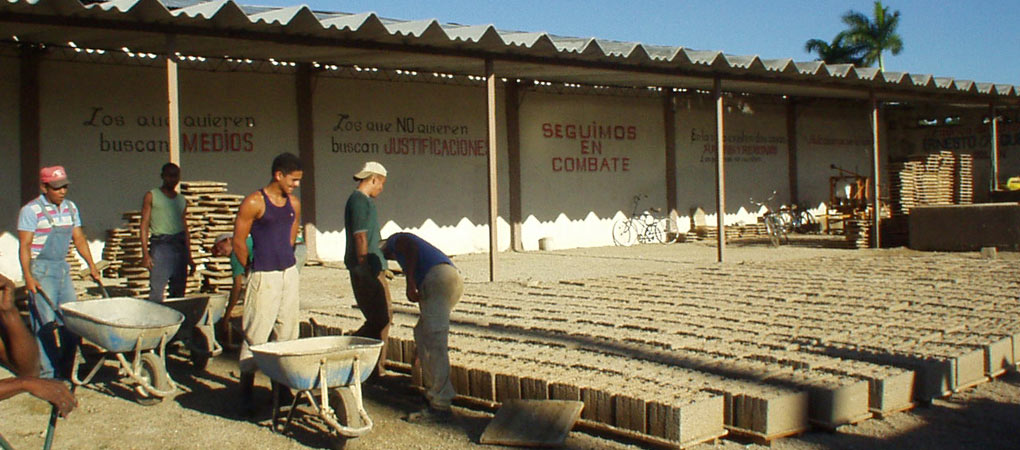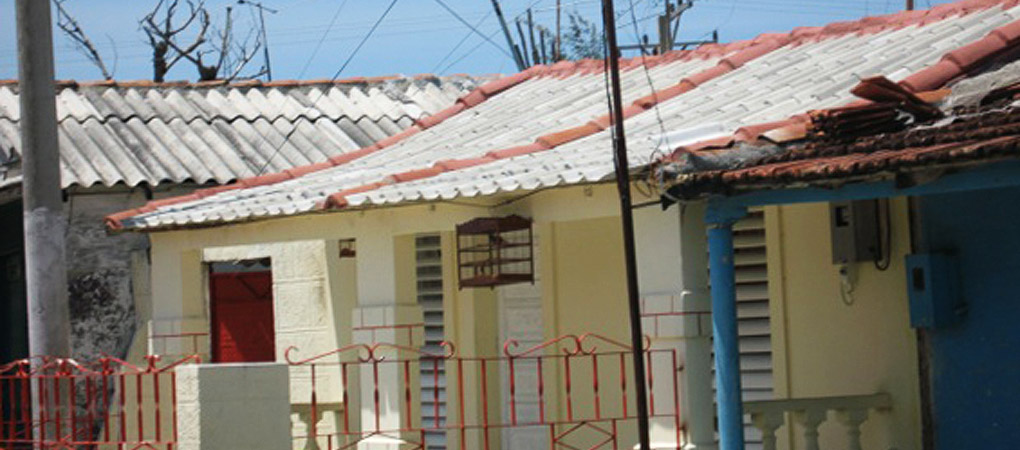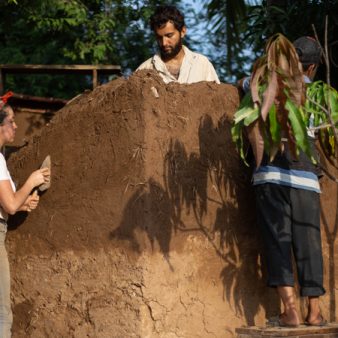Project Description
Aims and Objectives
The main purpose of the project is to develop and disseminate an innovative, transferable system for the local production and distribution of environmentally- and economically-sustainable building materials at municipal scale, facilitating access to families whose homes are in need of repair, particularly in disaster-prone areas.
Project context
From 1959-1988, the system for housing provision in Cuba was based on the centralised production of building materials in large, automated facilities operated by the Ministry of Construction. Prefabricated building materials were produced and supplied by road or rail to areas far from the industrial centres; it was an energy-intensive system based upon the supply of cheap oil from the former USSR.
The collapse of the Soviet Union and East European socialist states had a dramatic effect on the system: energy became scarce, roads deteriorated because of the lack of maintenance, the fleet of trucks became obsolete and the supply of spare parts was threatened. This had a great impact on the construction materials industry, which was no longer able to maintain a steady supply of building materials, particularly to areas distant from the production centres. The lack of availability of building materials led to a decrease in new housing construction and a rapid deterioration of existing housing stock due to lack of maintenance, as the population did not have the means to renovate or maintain their homes in good repair.

The new situation prompted a fundamental shift from centralised production based on long-distance transportation, to the local production of building materials in order to lower energy and transportation costs.
The work of the CIDEM research and development institute since it was established in 1991 has consisted of developing and implementing technologies to support this change at the grassroots level.
Key features
The project involves the development of a system for the local manufacture of ‘ecomaterials’ – building materials made with low embodied energy, often through recycling wastes. These include micro-concrete roofing tiles (MCR); lime-pozzolana cement (CP-40); pre-cast hollow concrete blocks, where Portland cement has been partially replaced by CP-40; low-energy fired clay bricks using bio-wastes as fuel; and the use of bamboo in construction. Suitable for both rural and suburban areas, the technologies developed by CIDEM are geared towards small-scale production, with a focus on stimulating the local economy through the creation of new job opportunities. The project’s main features include:
- An innovative process of technology development and transfer, which has resulted in a set of appropriate technologies for the manufacture of building materials at municipal level. The whole process has been organised as a south-south endeavour, as machinery and know-how come from Cuba and other countries in Latin America. Ecomaterials workshops are carried out that include personnel training and a post-sale advisory service.
- A large-scale decentralised programme for production of building materials at municipal level, which contributes to providing affordable and accessible building materials in a sustainable manner, particularly in areas where hurricanes have caused serious damage and a quick post-disaster response is required.
- Creation and further improvement of a new decentralised management model for housing renovation, which gives local authorities new opportunities to act independently as well as increase their capacity for resolving urban renewal issues. The model includes a micro-credit system that enables families with limited resources to finance the renovation of their homes.
There are currently 19 ecomaterials workshops in full operation throughout Cuba, and another 15 worldwide, including Latin America (Mexico, Nicaragua, Honduras, Panama, Guatemala, Colombia, Ecuador), Africa (Namibia, Nigeria, Mozambique), the Middle East (Yemen) and Asia (Bangladesh).
CIDEM has also been involved with the development of projects for the mitigation and prevention of damage to housing in the event of hurricanes and other disasters. The results of this work can be seen in the fast recovery after hurricanes Michelle (2001), Dennis (2005), Gustav and Ike (2008) which struck Cuba between 2001 and 2008. CIDEM constantly seeks to develop new appropriate construction materials and is currently implementing the first stage of the project of bamboo-biomass, which allows the use of this material for new construction, as well as the improvement of existing housing.
Covering costs
Funding for the project has been organised in a creative way. External funding of US$ 387,000 in foreign currency has been raised from a range of donor agencies including the European Commission, GTZ, the Swiss Development Cooperation and private foundations. These funds have been used to cover costs of goods that must be purchased in foreign currency, such as certain building materials, machinery, fuel for local transport, etc. The local governments have matched these funds with local currency, which has been used for the purchase raw materials, investments in infrastructure and the payment of salaries in the workshops. The total amount of funds provided by the local governments in the Villa Clara province is estimated to be two million Cuban pesos (equivalent to US$ 90,000). Funds for south-south technology transfer, through workshops carried out by CIDEM and the EcoSur network, have been provided by the European Union, the Cuban government and German NGO ‘Werkhof Verein’.
Impact
- Residents have more opportunities for the renovation of their homes through the availability of affordable building materials produced in the municipality.
- The project has contributed to improvement of the quality of the housing stock, especially in disaster-prone areas of the province of Villa Clara, where over 2,300 families have been able to renovate their homes, resulting in significant improvements in quality of life.
- Ecomaterials have gained recognition and prestige in the national and international arena, and new markets for local productions have emerged both within Cuba and elsewhere.
- CIDEM’s scientific and technical expertise is reflected in local knowledge and has been incorporated at all educational levels, including university curricula.
Why is it innovative?
- The development of a set of sound appropriate technologies for the manufacture of ecomaterials. This is supported by a continuous and integrated process of innovation, which combines fundamental and applied research, machinery development and manufacture, sales and post-sales service.
- The fact that these technologies and their use in ecomaterials manufacturing workshops have been successful and resulted in the massive production of building materials in a decentralised way, together with the new approach, has demonstrated that there are alternatives that decrease foreign currency costs through the local production of ecomaterials.
- The decentralised management model for housing renovation has yielded great success in its implementation and wide acceptance by the community. The municipalities where the approach has been applied have incorporated it into their own local strategies for development.
- That Cuba has become a ‘technology exporter’ through this process: approximately 50 inquiries are received each month on the different technologies for manufacturing of ecomaterials, primarily from Latin American countries.
What is the environmental impact?
- Materials are produced and sold directly in the community, with very low energy input and minor transportation costs.
- The alternative binder CP-40, one of the key materials introduced in the project requires less energy than Portland cement, and, therefore, has lower CO2 and SO2 emissions. Estimates of the embodied energy in the range of 2.8 MJ/kg, depending on the source of lime. This represents less than half of the embodied energy in the manufacture of Portland cement, which ranges from 5-7 MJ/kg in most countries in Central America, resulting in substantial energy savings.
- The fact that the materials are produced locally avoids a major part of the transportation costs associated with conveying the products from distant places, thereby contributing to savings of energy and fuel.
- Decreased energy consumption during manufacture of building materials: the ecomaterials require less energy than industrial materials, because the technology is labour-intensive and the machinery is designed to optimise energy use.
- The low-energy production of fired clay bricks involved the use of alternative fuel and lower carbon emissions.
- The recycling of potentially hazardous waste materials, such as sugar cane straw ash, into the manufacture of building materials presents a viable alternative to protect the environment and make agro-industrial processes more sustainable.
Is it financially sustainable?
Institutional and project funding has been secured from different donors until 2010. The project enjoys full support from the national government, and even if political circumstances were to change in Cuba between now and 2010, it is unlikely that government support for the local production of construction materials would decrease. The local production system developed by CIDEM is designed to be self- sustaining, and the workshops established to date have demonstrated financial sustainability.
There are currently 19 new building materials workshops in commercial operation in Cuba and a total of approximately 200 new direct jobs have been created, as well as a large number of indirect jobs (in masonry, carpentry), as a consequence of the boost in the local construction market.
One of the primary aims of the project has been to make building materials more affordable and accessible to local people. The combination of local production of materials and access to credit has enabled the population to undertake housing renovation or construction, which would otherwise have been hindered by the lack of funds and access to building materials.
What is the social impact?
Residents have organised themselves into formal mutual-help brigades to build, repair or renovate their homes. This process has strengthened social networks and resulted in innovative ways of cooperation between neighbours, and helped to create additional job opportunities in the informal sector.
As a result, small communities have acquired their own means of locally producing affordable building materials and supplying them to the local market. During the first year of operation, CIDEM made regular visit to new workshops to provide training and support and ensure that the production complied with existing quality standards, after one year, the visits became less regular, as local partners had acquired the needed skills and workshops became self-sufficient.
Special priority has been given to families whose houses were damaged by natural disasters (hurricanes or floods). Access to credit and materials allow families to respond quickly rather than wait for state assistance in repairing their homes.
The way in which the system has been implemented aims at reducing social inequalities. The credit line in particular favours families with very low income, who otherwise have no means of purchasing building materials. More than 30 per cent of the project’s beneficiaries are single mothers.
A local and decentralised model for house construction and renovation has been created, whereas the local government contributes with financial resources and manages the whole process, prioritising the worst cases in the municipality. The system developed is based upon direct participation of house owners through assisted self-help. It has proven to be more efficient than existing models in Cuba.
Barriers
- Because of the current budgetary system in Cuba, funds in foreign currency are only accessed by national bodies, based on governmental priorities, which limits the acquisition of machinery for the manufacture of the ecomaterials at municipal level. Overcome through the contribution of international donors, who provided the needed funds in foreign currency.
- Many low-income families who want to renovate their houses on their own do not have the funds to pay up front for the needed materials. The credit provided by INV does not consider these cases. Overcome through direct negotiation with the Banco Popular de Ahorro, which has issued a special credit line for low-income families involved in house renovation.
- The producers are not familiar with the new technologies and materials, particularly the pozzolanic cement. Previous experiences with similar technologies in the past failed because of poor quality control, and the product lost prestige and was associated with poor performance. Overcome through training and advocacy work within the community.
- The rigid system of the Ministry of Higher Education in Cuba imposes many operational and structural restrictions Overcome through a lot of creativity in daily operation.
Lessons Learned
- A solid, efficient infrastructure for the local manufacture of building materials allows for independence from external sources.
- Local governments must seek ways to contribute towards the financial and social viability of the newly created manufacturing facilities and the population must actively participate in sustainable housing renovation programmes.
- The technologies developed and implemented by CIDEM have proven to be both economically and ecologically appropriate. They are a good choice for small-scale production of building materials, mainly because of the huge transportation savings achieved with local production, as well as the high standard of quality of the materials.
- Coordination with a broad spectrum of actors has been crucial to implementation and has led to broad acceptance and scaling up of the project to national level. Inclusion of the bank at the planning and implementation stage was especially important for the mobilisation of financial resources through loan schemes that directly benefit the project’s target group.
Evaluation
The PIME (Planning, Implementing, Monitoring and Evaluation) system, developed by SDC and NGO Grupo Sofonias, is used as a monitoring tool. Intermediate evaluations have been carried out by the local partners at the municipality where each workshop operates, followed by a final evaluation at the end of Phase I.
Transfer
The approach is being successfully implemented in other municipalities and neighbouring provinces. Funding has been secured for the second phase of the project, which will involve a further scaling up and dissemination of the technologies in a wider context over the next five years, particularly in areas affected by natural disasters.
The system has gained popularity among local governments in the province, which are playing a key role in the local transfer of the approach.
Different government institutions at various levels have shown interest in replicating the initiative with their own funds. Local governments in Sancti Spiritus, Santiago de Cuba, Pinar del Rio and Havana as well as international donors such as UNDP, CIDA, SDC and others have taken steps to replicate the experience in other municipalities.
In 2002 the National Housing Institute set a network of eco-materials into operation in the province Matanzas, as a means to tackle the problems caused by hurricane Michelle. More than 600,000 blocks were produced in four workshops. INV has joined forces with CIDEM to further transfer the approach in other regions of the country.
The project is currently active in 33 municipalities across five provinces, and it is anticipated that over the next five years several thousand homes will be built and/or renovated in Cuba using locally-produced eco-materials.
The approach has been disseminated and transferred outside Cuba through EcoSur network. Eco-materials workshops were set into operation in Nicaragua and Honduras. The governor of Morelia, Mexico, in 2005 placed an order for 14 workshops to be set into operation throughout the state. Additional workshops are currently in operation in Colombia, Ecuador, Guatemala, Honduras, Mexico, Nicaragua, Bangladesh, Nigeria, Mozambique and Yemen.
Partnership
NGO, local government, national government, international donors




